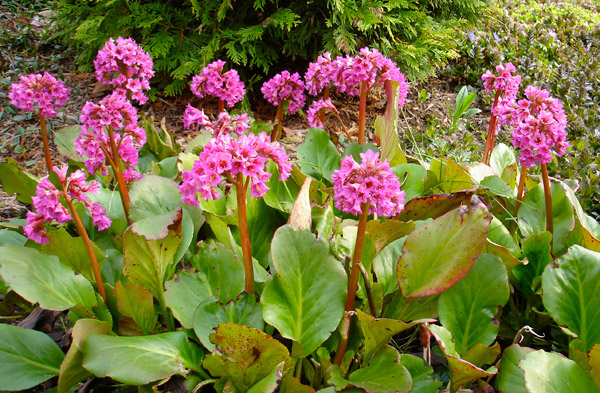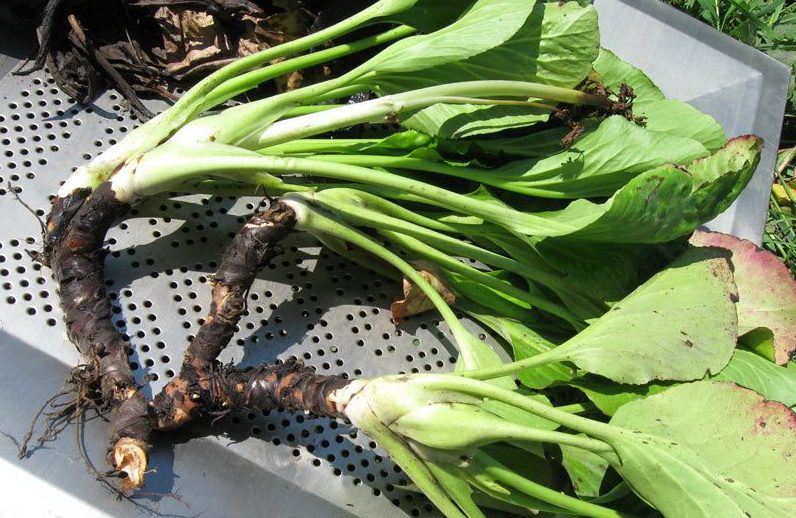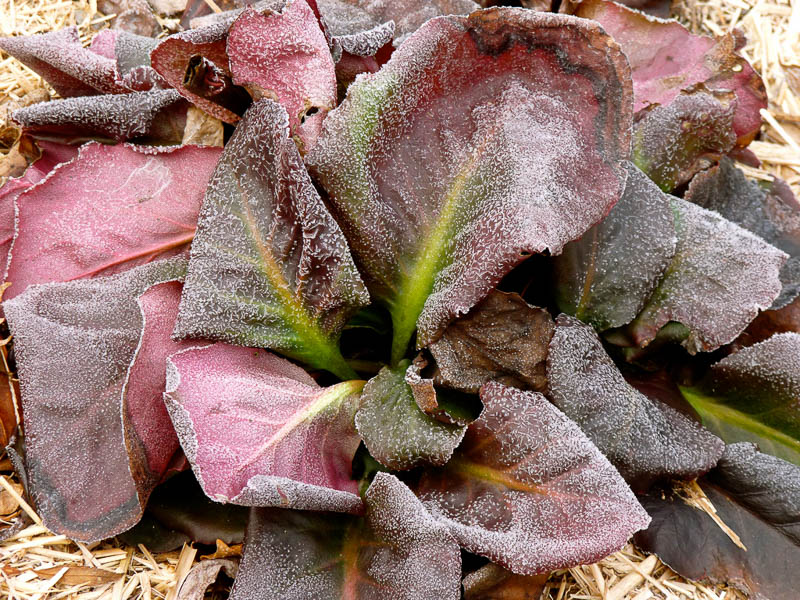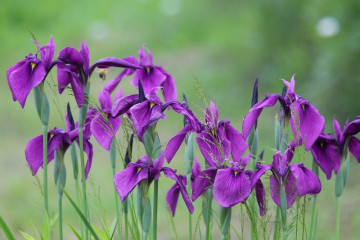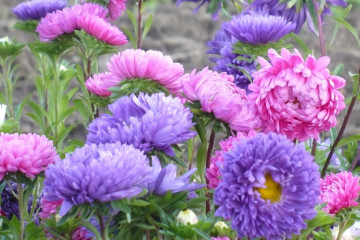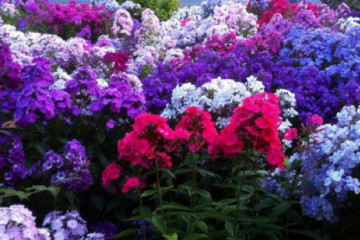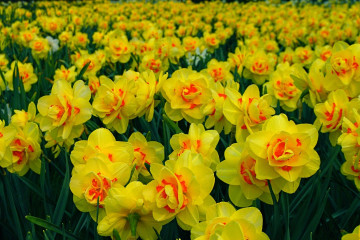Badan planting and care in the open field
Content:
Badan plant is unpretentious, grows well in the shade and in the sun. Differs in a quick change of colors: from green to bright red. Changes take place over one cold autumn night, with the onset of the first frost. The poured stems and leaves are preserved all year round, they look original from melted snowdrifts.
Description of the badan plant
Badan flower is a perennial herbaceous culture of the Saxifrage family. It is widely used in Europe for decorating gardens and flower beds, in Russia it is rather rare in garden plots. The plant stretches in length up to 60 cm. The leaves are voluminous, shine, have a rounded shape, dark green color, collected at the root in a rosette. White, pink, blue, purple bells are collected (up to 120 pieces) in thyroid inflorescences. The size of the flowers is up to 2 cm in diameter. Badan with bright flowering pleases flower growers from late March to early June.
Popular species and varieties
There are few varieties of badan, about 10 subgroups of wild and cultivated varieties. In the climatic conditions of Russia, it will turn out to plant several varieties of badan: thick-leaved, heart-leaved, Pacific.
Thick-leaved bergenia
Occurs in glades and meadows of Altai, Transbaikalia, Kazakhstan, China. The cultivation and care of thick-leaved bergenia will provide medicinal herbs with anti-inflammatory and antiseptic properties. The leaves of the crop are used to make healthy teas that help with colds, cystitis, and indigestion.
Externally, the plant is represented by a compact bush 60 cm long. Large leathery foliage has a rich green hue, by autumn, adult plants take on a bright red color. Flowers of big-leaved incense are bell-shaped, form large inflorescences. The culture blooms magnificently for 3-4 weeks. The best varieties of thick-leaved badan for growing in the gardens of Russia - Giderruspe, Purpurea, Senor.
Bergenia cordial
The description of the bergenia cordifolia variety is determined by the growing conditions. On average, the height of the shoots is 30-40 cm, the leaves are voluminous, have a heart-shaped shape, a rich green hue. The flowers are pink or lilac-pink (less often white or purple), form racemose inflorescences.
Heart-leaved incense blooms actively in late spring. Copes well with severe frosts.
Badan pacific
In the wild, it is found in the Far East, China and Korea. If properly cared for, the shoot of flowers reaches 40 cm. The foliage is voluminous (maximum 20 cm in diameter), ovoid, colored light green, forms a convex vein in the center. Flowers of deep pink tones, collected in inflorescences.
The healing properties of badan
In scientific medicine, badan is well established as a medicinal raw material.For medicinal purposes are extracts of leaves and roots of the culture. Bergenia-based preparations are used for gastrointestinal diseases, as well as in gynecology as a hemostatic agent in the treatment of the cervix. Badan roots are also useful for colitis, enterocolitis of non-infectious origin.
The dried, darkened foliage of the culture is brewed for aromatic teas - Mongolian or Chigir varieties. The drink has anti-inflammatory and bactericidal properties, lowers blood pressure, normalizes the nervous system, intestinal microflora, helps to solve gynecological problems and acute respiratory infections. The medicinal properties of the plant are effective for pneumonia, gum disease, and stomach diseases.
Planting and reproduction in the garden
How and when to plant
The use of seedlings is the most convenient way to grow incense planting and care in the open field begins in early August. Many gardeners sow in June without diving the plant, but the seedlings are too weak. Experienced gardeners recommend planting strong and developed bushes at the beginning of summer, the remaining ones - to dive and grow at home until August, then transplant into the garden.
Planting rhizomes with rosettes
Experienced gardeners, before propagating incense vegetatively, separate rosettes with roots located close to the surface from May to August. At least three buds are left on separate segments of the rhizome. The lower leaves from the cuttings must be cut off, the cuttings must be transplanted into the holes at a depth of 3-5 cm, in increments of 30-40 cm.
In the first year, rooted plants build up the outlet, begin to bloom in the second or third year.
Planting rhizomes with dormant buds
To propagate the roots of bergenia with dormant buds, you will need to dig out the underground part of the plant containing 5-6 dormant buds. Store seedlings in a dark and cool place, shifting with aerated paper or straw. Before planting, the rhizomes are kept in a weak solution of potassium permanganate or copper sulfate for 2-3 hours, treated with a fungicide, preventing possible diseases.
Planting and growing in pots
Badan has the ability to bloom well and multiply in tubs or pots, providing easy transportation of the decor.
Planting in pots is carried out in several stages:
- The bottom of the pots is drained with expanded clay, pebbles or crushed stone, by ¼ of the volume.
- Fill the container up to half with a substrate based on sod, leafy soil, compost, sand in a ratio of 2: 2: 1: 1.
- The badan rosette is placed in the central part of the pot, sprinkled with the remains of the earth.
- Lightly burn the soil around the plant and watered.
- The upper part is mulched with bark, pebbles or decorative gravel.
For the winter, it is recommended to move a pots or a tub with a flower to a greenhouse or to a veranda, covering it with lutrasil. In regions where the frost does not drop below 5 degrees, plants can hibernate outside.
Generative breeding method
Badan seeds are planted in a container or pallet before winter, allowing the sprouts to grow stronger in favorable conditions. Sprouts that have reached a size of 10-15 cm allow you to determine when to transplant berry into open ground. A couple of years after planting, the culture will bloom.
Pruning
In the spring, as the snow melts and the earth dries up a little, part of the damaged foliage is removed from the saxifrage. It is not recommended to completely prune the leaves - the dying shoots retain soil moisture and maintain the temperature necessary for shallow roots. In the month of March, it is useful to shorten the overgrown shoots.
How to care outdoors
Soil selection and preparation
Bergenia is planted in an elevated area in partial shade.In low and damp places, perennial shrubs will form flowers quite rarely, which is caused by decay of the rhizome with excess moisture. Saxifrage prefers to grow in sod soil with low neutral acidity - pH 5.5-6.5.
The soil must be well drained.
Watering rules
The first watering of the grass is carried out as the buds are formed, the second - during the flowering period, the third - on the 15-20th day of the dormant period. It is recommended to moisten the soil during the dry season. If it rains regularly, there will be enough natural rainfall for the bergenia.
After landing
In spring, care when planting badan in open soil begins with breaking off spoiled leaves. Then the soil under the plant is mulched and fertilized with the universal fertilizer "Kemira Lux". It is necessary to water the perennial as needed, excluding the drying out of the soil.
In spring and autumn, during the flowering period
The healing healer is responsive to feeding during the period of bud formation. As soon as the culture blooms, it is necessary to stock up on a complex of mineral fertilizers and, after 3 weeks, to provide plant nutrition. In autumn, the culture is watered with a solution of superphosphate mixture at the ratio: 20 g per bucket for irrigation of 1 m² of soil.
Preparation for wintering
Badan (bergenia) hibernates in open soil without shelter, but can be damaged by the wind. To prevent the leaves from drying out, the plant is watered during the cold period.
Growing and care problems
Why the plant does not give inflorescences
Badan bloom is delayed under the following conditions:
- The plant is young. The main reason why badan does not bloom is growing from seeds, the chosen breeding method is accompanied by late flowering: in the third or fourth year after sowing, it is worth waiting a little.
- The flowers are densely planted. It is advisable to plant bergenia.
- The culture has recently or often been transplanted - an additional reason why berry bushes do not bloom. What to do? Wait until the plant adapts to a new place, provide complex fertilizing with minerals.
- Not enough light. A similar situation is possible if the bushes are shaded with old trees with wide crowns.
Badan does not give color when affected by a fungus. Growing a flower in swampy areas, constant moisture ends with diseases that affect the leaves and peduncles.
Leaves curl
The cause of leaf deformation is more often gaps in the care:
- if you plant it incorrectly;
- ensure nutritional deficiencies;
- lack of moisture;
- sudden changes in temperature;
- do not prevent the attack of pests;
- diseases.
Determination of the problem begins with a close examination of the shoots and leaves, analysis of weather conditions, and care actions.
Pest and disease control
The peculiarities of the chemical composition allow the badan to easily cope with the attack of pests. However, in clay soil or with poor drainage, the rhizome is prone to rotting. A crop grown in the shade is attacked by a slobbery penny. Also, perennials are attacked by nematodes, the fight against earthworms will not be difficult if the rhizomes are treated with a manganese solution. Then you will need to transplant to a new location. Areas attacked by nematodes are disinfected with chemicals.
Use in landscape design
Colorful varieties of badan are applicable for the formation of multi-level flower beds of medium and large sizes. Badan is planted more often at the foot or at the penultimate step. In the shade, the culture produces juicy and large foliage, in the sun it pleases with abundant flowering, the leaves are less lush.
The perennial shows itself in the best way when decorating paths, the foreground of flower beds and flower beds, as an evergreen ground cover, an element of large mixborders.Saxifrage is also used as a tapeworm, placing the plant against the background of a well-groomed emerald lawn. In the fall, culture draws attention to the swings of greens and reds.
With proper care, berry grows actively and pleases with colorful flowering.
